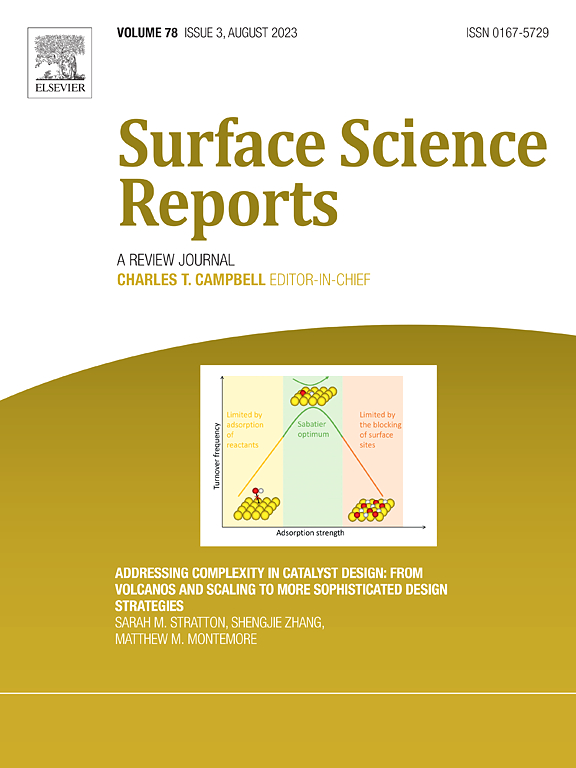自由基表面化学:自由基在水界面上增强反应活性
IF 8.7
1区 化学
Q1 CHEMISTRY, PHYSICAL
引用次数: 0
摘要
协同性和非加性相互作用在水的不寻常和令人惊讶的行为中起着核心作用。一系列活性氧(ROS),包括羟基自由基•OH、超氧阴离子自由基(O2−•)、氢过氧化物自由基(HO2•)、单线态氧(1O2),以及最近讨论的水自由基阳离子/阴离子对(H2O+•/H2O−•),都加入了水合氢离子(h30 +)和氢氧根(OH−)所走过的更熟悉的酸碱化学途径。这在表面科学中被放大了,因为界面水——无论是在气/液、气/固还是液/固界面上发现的——表现出更独特的行为。本文综述了与常温水界面相关的意想不到的化学反应,其中许多化学反应不仅是由离子和中性离子介导的,而且还包括自由基。水微滴催化许多反应,也可以通过产生反应中间体来支持同时发生的氧化和还原反应,这些反应中间体的存在是由于空气/水或油/水界面的独特影响。界面水影响并受无处不在的接触起电现象的影响,这是一种自发对称性破缺的表现。不仅在微滴表面和微滴内部,而且在气体/固体和液体/固体界面上的化学机制依赖于自由基介导的一系列广泛的化学转化。此外,由于水的宏观和微观界面在地球上无处不在,我们发现水自由基介导的化学在大气化学、地球化学、矿物风化、生物前化学、增强酶性能、废水修复、公共卫生、机械化学以及潜在的药物新途径中都有应用。本文章由计算机程序翻译,如有差异,请以英文原文为准。
Radical surface chemistry: Augmentation of reactivity by radicals at aqueous interfaces
Cooperativity and non-additive interactions play central roles in the unusual and surprising behavior of water. A host of reactive oxygen species (ROS) including the hydroxyl radical •OH, superoxide radical anion (O2−•), hydroperoxide radical (HO2•), singlet oxygen (1O2), and also the more recently discussed water radical cation/anion pair (H2O+•/H2O−•) all add to the more familiar acid/base chemical pathways tread by hydronium (H3O+) and hydroxide (OH−). This is amplified in surface science because interfacial water – whether found at the gas/liquid, gas/solid, or liquid/solid interface – poses yet more unique behavior. This review explores the unexpected chemistry associated with ambient temperature aqueous interfaces much of which is mediated not only by ions and neutrals as expected, but also radical species. Water microdroplets catalyze numerous reactions and can also support simultaneous oxidation and reduction reactions through the production of reactive intermediates that owe their existence to the unique influence of the air/water or oil/water interface. Interfacial water influences and is influenced by the ubiquitous phenomenon of contact electrification, a manifestation of spontaneous symmetry breaking. The mechanisms of chemistry not only on and in microdroplets but also at the gas/solid and liquid/solid interfaces rely on a broad set of chemical transformations mediated by radicals. Furthermore, because aqueous macro- and micro-interfaces are ubiquitous on Earth, we find that water radical-mediated chemistry has applications to atmospheric chemistry, geochemistry, mineral weathering, pre-biotic chemistry, enhanced enzyme performance, wastewater remediation, public health, mechanochemistry, and potentially novel routes to pharmaceuticals.
求助全文
通过发布文献求助,成功后即可免费获取论文全文。
去求助
来源期刊

Surface Science Reports
化学-物理:凝聚态物理
CiteScore
15.90
自引率
2.00%
发文量
9
审稿时长
178 days
期刊介绍:
Surface Science Reports is a journal that specializes in invited review papers on experimental and theoretical studies in the physics, chemistry, and pioneering applications of surfaces, interfaces, and nanostructures. The topics covered in the journal aim to contribute to a better understanding of the fundamental phenomena that occur on surfaces and interfaces, as well as the application of this knowledge to the development of materials, processes, and devices. In this journal, the term "surfaces" encompasses all interfaces between solids, liquids, polymers, biomaterials, nanostructures, soft matter, gases, and vacuum. Additionally, the journal includes reviews of experimental techniques and methods used to characterize surfaces and surface processes, such as those based on the interactions of photons, electrons, and ions with surfaces.
 求助内容:
求助内容: 应助结果提醒方式:
应助结果提醒方式:


